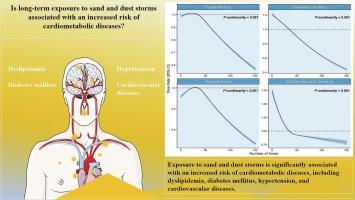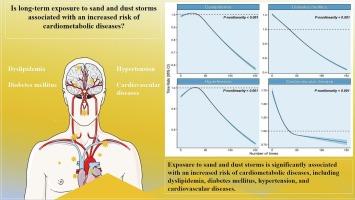Risk of sand and dust storms on cardiometabolic diseases: a cohort study of over 2.2 million participants
IF 9.7
1区 环境科学与生态学
Q1 ENVIRONMENTAL SCIENCES
引用次数: 0
Abstract
Climate change has intensified the occurrence of sand and dust storms (SDS), contributing to an increasing public health burden. However, limited evidence exists on the long-term impact of SDS exposure on the incidence of cardiometabolic diseases (CMDs). In this study, we analyzed data from a population-based cohort of 2,260,855 individuals in Northwestern China (2019–2023). Individual-level SDS exposure over a three-year period was estimated using three machine learning models, with extreme gradient boosting demonstrating the best predictive performance. An Accelerated Failure Time (AFT) model was employed to explore the association between SDS exposure and CMD risk, including dyslipidemia, diabetes mellitus, hypertension, and cardiovascular disease. Restricted cubic spline (RCS) analysis revealed a non-linear association between SDS exposure and the time to onset of CMDs. Compared to participants exposed to SDS in the first tertile, those exposed in the highest tertile experienced earlier onset of dyslipidemia (Time Ratio [TR]: 0.854, 95 % CI: 0.848–0.860), diabetes mellitus (TR: 0.784, 95 % CI: 0.776–0.793), hypertension (TR: 0.914, 95 % CI: 0.906–0.922), and cardiovascular disease (TR: 0.732, 95 % CI: 0.714–0.752). Subgroup analysis indicated that individuals aged <50 years, those with obesity (BMI > 25 kg/m2), smokers, drinkers, and individuals with a family history of CMDs were more susceptible to the adverse effects of SDS, leading to a significantly earlier onset of CMDs. These findings suggest that chronic exposure to SDS significantly elevates CMD risk, underscoring the need for public health strategies and air quality standards that address SDS-related health impacts, especially for vulnerable populations.


沙尘暴对心脏代谢疾病的风险:一项超过220万参与者的队列研究
气候变化加剧了沙尘暴的发生,导致公共卫生负担日益加重。然而,关于SDS暴露对心脏代谢疾病(CMDs)发生率的长期影响的证据有限。在这项研究中,我们分析了来自中国西北地区(2019-2023)的2,260,855人的基于人群的队列数据。使用三种机器学习模型估计了三年内个人水平的SDS暴露,极端梯度增强显示了最佳的预测性能。采用加速失效时间(AFT)模型探讨SDS暴露与CMD风险(包括血脂异常、糖尿病、高血压和心血管疾病)之间的关系。限制性三次样条(RCS)分析显示SDS暴露与CMDs发病时间呈非线性关系。与第一分位暴露于SDS的参与者相比,暴露于最高分位的参与者出现了更早的血脂异常(时间比[TR]: 0.854, 95 % CI: 0.848-0.860)、糖尿病(TR: 0.784, 95 % CI: 0.776-0.793)、高血压(TR: 0.914, 95 % CI: 0.906-0.922)和心血管疾病(TR: 0.732, 95 % CI: 0.714-0.752)。亚组分析显示,年龄≥50 岁、肥胖(BMI >; 25 kg/m2)、吸烟者、饮酒者和有CMDs家族史的个体更容易受到SDS不良反应的影响,导致CMDs发病明显提前。这些发现表明,长期暴露于SDS会显著提高CMD风险,强调需要制定公共卫生战略和空气质量标准,以解决SDS相关的健康影响,特别是对弱势群体。
本文章由计算机程序翻译,如有差异,请以英文原文为准。
求助全文
约1分钟内获得全文
求助全文
来源期刊

Environment International
环境科学-环境科学
CiteScore
21.90
自引率
3.40%
发文量
734
审稿时长
2.8 months
期刊介绍:
Environmental Health publishes manuscripts focusing on critical aspects of environmental and occupational medicine, including studies in toxicology and epidemiology, to illuminate the human health implications of exposure to environmental hazards. The journal adopts an open-access model and practices open peer review.
It caters to scientists and practitioners across all environmental science domains, directly or indirectly impacting human health and well-being. With a commitment to enhancing the prevention of environmentally-related health risks, Environmental Health serves as a public health journal for the community and scientists engaged in matters of public health significance concerning the environment.
 求助内容:
求助内容: 应助结果提醒方式:
应助结果提醒方式:


